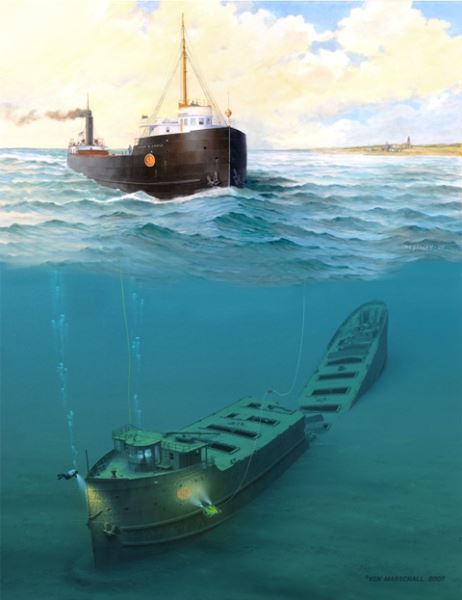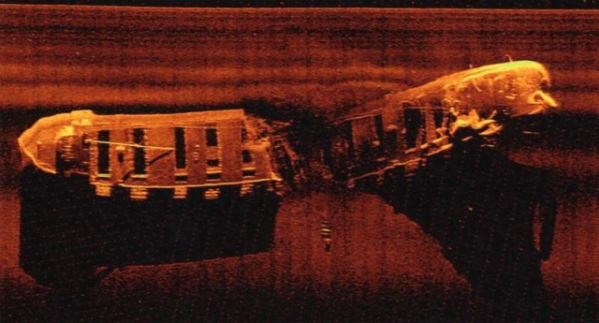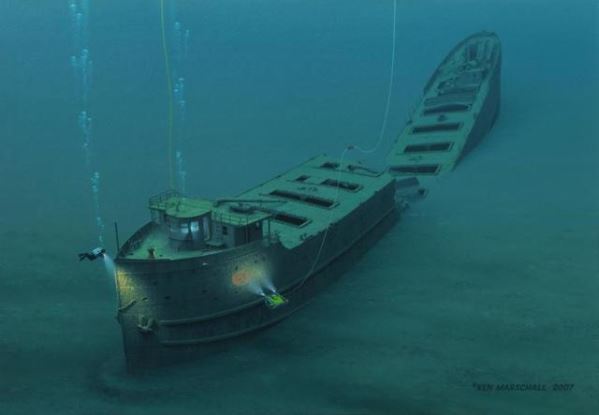 The clock struck 5 a.m. The water was nearly still under the thick blanket of fog that coated every molecule of air around the John B. Cowle. Where they were heading, Whitefish Point, was well-known for the treachery that hid behind the veil. Captains are always warned to stay alert for incoming obstacles, and, as advised, Captain Rogers was awake – even that early in the morning.
The clock struck 5 a.m. The water was nearly still under the thick blanket of fog that coated every molecule of air around the John B. Cowle. Where they were heading, Whitefish Point, was well-known for the treachery that hid behind the veil. Captains are always warned to stay alert for incoming obstacles, and, as advised, Captain Rogers was awake – even that early in the morning.
In a heartbeat, disaster struck. In three minutes, the John B. Cowle was cleaved in two and utterly demolished, taking 14 of its passengers with it. Having been awake, Captain Rogers quickly abandoned the ship with his son. Those who escaped survived to tell the tale of the sinking of the John B. Cowle.
Dangerously Deep
The John B. Cowle was a steel ore carrier built in 1902. It was the first of two ships owned by the prominent Ohio figure John Beswick Cowle, for whom the ship received its name. The second was a ship named Erin which sank in 1906 about three years prior to the destruction of the Cowle.
Being built in 1902, the John B. Cowle was a relatively new ship before sinking in 1909. All things considered, it had several years of service still ahead of it. Perhaps it was the man who built the Cowle simply had bad luck, or maybe there was something more sinister in the accidents surrounding the boats that John Cowle had built, but due to the shortness of its lifespan and the newness of the ship, the real significance of the John B. Cowle showed when it went down.
Shipwrecked
On July 12, 1909, the John B. Cowle was downward bound, carrying 7,023 tons of iron ore that was destined for Cleveland, Ohio. The significantly larger ship, the Isaac M. Scott was a new steel steamer running light after just finishing dropping off its cargo in Duluth, Minn.
The John B. Cowle had slowed down to half speed since the fog at Whitefish Point was becoming treacherously precarious. This area has had quite a few accidents plague it over the years, and, according to Bruce Lynn, the executive director of the Great Lakes Shipwreck Museum, “The Whitefish Point area is well known for its bad weather conditions. There were many fog signals along that stretch of shoreline back when the Cowle sank. They had a loud fog horn that could be heard for miles and a critical turning point that most captains were well aware of.”
The Isaac M. Scott was making a maiden voyage and moving at full speed. In an instant, and what felt like without warning, the Isaac M. Scott loomed over the broadside to the John B. Cowle. By the time anyone realized what was happening, it was too late for the Cowle.
Because of where the John B. Cowle was struck, boilers began to explode, causing considerable damage to the ship. Quickly, water began to weigh the ship down. Time for any passengers to escape was quickly dwindling.
The rear cabins were ripped open, likely taking anyone who was still asleep in that part of the boat. The ship was split in two with the bow facing upright and the rear sinking just a moment quicker than the rest of it.
In less than five minutes, the Cowle was gone, taking with it 14 of a 24-man crew. The Isaac M. Scott was able to rescue a few of the passengers, still floating on past the scene of the wreck.
 Learning From Tragedy
Learning From Tragedy
While the shipwreck caused a lot of loss, at the very least, there is something to be gained from the tragedy. For one, the site of the John B. Cowle wreck is being preserved for future generations of scuba divers by the Whitefish Point Underwater Preserve as part of an underwater museum.
When asked about what we can take away from the tragedy, Lynn states, “You can learn a lot about the technology of the day from discovering these ships. All things considered, the John B. Cowle did not lose a whole lot. A lot of things are still intact.”
Lynn is an avid history lover whose family has lived just south of Whitefish Point for a long time. He approaches these sorts of things with a historical lense, and has worked for the Great Lakes Shipwreck Museum for ten years. He says that a lot of Great Lakes history can be taken away from these instances, bringing us insights to the past that we may not otherwise have had.
Photos courtesy of Great Lakes Shipwreck Museum
For More Information
Great Lakes Shipwreck Museum
www.shipwreckmuseum.com

